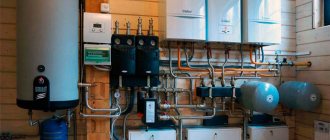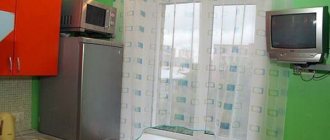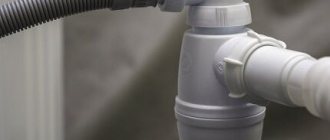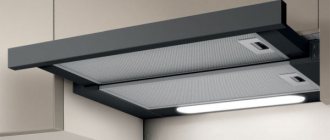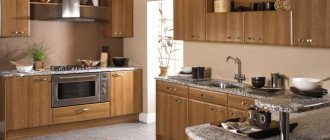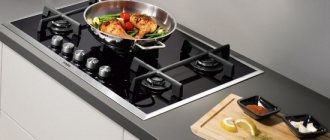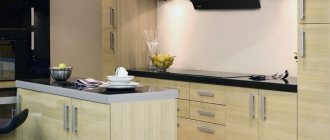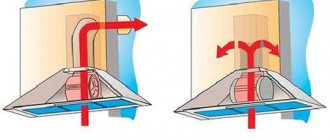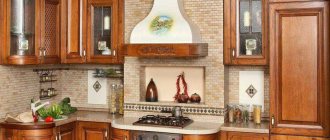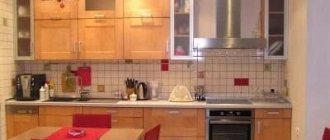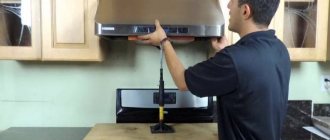Hood tasks
Any model of hood suitable for power is suitable for a gas stove.
Hoods for a gas stove perform the following functions:
- remove harmful substances and unpleasant odors from the kitchen air;
- ensure the safe operation of the gas appliance;
- maintain comfortable conditions in the chef’s work area.
When gas is burned and food is cooked, harmful substances are released into the air, which must be eliminated in a timely manner. Carbon dioxide and carbon monoxide appear when the stove is on. Increased concentrations of substances worsen your health and can cause poisoning. The process of frying foods at high temperatures is accompanied by the release of carcinogens, which, when accumulated in the body, lead to cancer.
Cooking is accompanied by the release of various odors, which spread throughout the rooms and linger for a long time, permeating the upholstery of furniture and clothing. The aromas of several dishes, when mixed, can ruin your appetite. The hood will significantly reduce the concentration of odors in the apartment.
A natural gas leak from a burner that is extinguished or not turned off cannot always be detected in a timely manner, especially during cooking. The hood will protect against explosion for some time and will help to detect a malfunction in a timely manner.
Simultaneous cooking of several dishes causes heating of the air near the stove, and hot steam creates inconvenience. Timely heat removal makes work more enjoyable. Built-in lights make working at dusk or in the dark easier.
Filters for kitchen hoods
We figured out how to choose a kitchen hood over the stove. But filters are also important in this matter; they differ in many respects. By choosing the right filter, you will ensure optimal air purification and stable operation of the device, which will work at full capacity. What types of commercially available filters are divided into? How to choose them correctly?
First of all, it is worth saying that there are fine filters, as well as filters for collecting grease. Then they are classified depending on the material from which they are made.
- Metal. Made of perforated foil and fine metal mesh. This is a budget filter that does not need to be replaced, and its service life is the same as that of a hood (subject to careful use). The main advantage of this filter is that it can be cleaned, for example, in a dishwasher using mild chemicals.
- Synthetic. This filter will have to be changed as soon as it becomes dirty. An undoubted advantage is the minimum noise level of the hood. The disadvantage is that you will have to regularly spend money on purchasing new filters. Otherwise, the performance of the hood will decrease and energy consumption will increase.
- Carbonic. Ideal for fine cleaning, but its cost is quite high. Made in the form of a long filter with a compartment containing activated carbon. It is he who catches the smallest particles of dust and unpleasant odors. Coal is often mixed with silver ions, cations, etc. Regular replacement of the carbon filter is required - every 3-4 months. This means that you must be prepared for additional costs, and the cost of a carbon filter is higher than that of a synthetic one. If you do not change such a filter for more than 4 months, the hood above the stove will begin to pollute the air.
How to choose the right kitchen hood over the stove in a private house or apartment? Most buyers prefer a hood with an outlet equipped with a carbon filter. This device allows you to eliminate fumes, grease and unpleasant odors.
Recommended articles on this topic:
- Arrangement of a small apartment
- Stages of renovation in an apartment
- Turnkey cosmetic repairs
How the devices work
For a recirculation hood, you need to buy replacement filters.
Based on the principles of operation of exhaust devices, there are varieties:
- diverting;
- recirculation;
- universal.
Devices of the first type remove harmful substances into the ventilation duct due to draft or using a fan. Separate mines are built in apartment buildings. The channels do not intersect with hoods from bathrooms and living rooms. Among all types of purifiers, diverting models have the highest performance.
The equipment operates in passive or active mode - with the fan turned on or due to natural circulation. This is convenient, since the air in the kitchen is constantly updated.
According to current sanitary and fire safety standards, not every home is allowed to install hoods with a forced operating principle. Before purchasing an exhaust hood with a fan, you should consult with the management company.
Grease trap for recirculation hood
During inspection and maintenance of a gas stove, gas service workers have the right to issue an order to dismantle the device with forced circulation. The requirement does not apply to apartments on upper floors.
Recirculation models are equipped with filters. The air passing through the device is cleaned of harmful impurities. There is no connection to the entrance ventilation duct. An important disadvantage of recirculation models is the need to replace or wash filter elements, which entails some operating costs.
First-stage filters that catch grease can be non-woven, paper, synthetic padding - they are disposable and must be replaced 5-6 times a year. Acrylic options can be washed several times in the dishwasher. The service life is limited to 1.5 - 2 years and depends on the intensity of use. Carbon filter elements are installed, as a rule, in universal devices that operate for air removal and filtration.
Combined devices operate in two modes simultaneously or it is possible to use one of them. The devices are powerful and provide maximum air purification.
Exhaust mode
The first thing you need to decide is which air exhaust mode to choose. There are 2 options for kitchen hoods:
- Branch.
- Filtering.
Exhaust hood
A vent or flow-through hood is connected to the air duct. The device draws in fumes from above the stove and discharges them through an air duct into the ventilation shaft. A grease filter is installed inside. It is needed to protect the fan blades and the inside of the hood. Grease filters need to be washed once a month for the device to function properly.
Pros: good power, no need to buy an additional carbon filter.
Cons: difficult to connect to the ventilation system through an air duct.
Filter hood
It is worth choosing a filtering or recirculating hood if the kitchen does not have a connection to the air duct. The device takes in air above the stove, filters, cleans it and releases it back into the room. For this purpose, the product is equipped with two filters:
- Coal. The filter absorbs odors emanating from the stove and provides additional air purification.
- Zhirov. The filter collects droplets of grease and soot from the air flow above the stove.
Recirculating hoods do not reduce the increased humidity in the room during cooking. They also do not increase the amount of oxygen in the room. Sometimes the design of the device includes a UV lamp to disinfect the air above the stove.
Pros: can be connected in the kitchen, where it is not possible to connect the device to the ventilation system through an air duct.
Cons: power is less than that of flow-through hoods, the carbon filter quickly becomes clogged, it needs to be changed at least 2-3 times a year
Criterias of choice
The size of the hood must correspond to the size of the hob
Before purchasing hoods, individual needs are assessed. The choice is influenced by:
- geometric dimensions of the hob;
- dome shape and installation method;
- dimensions of kitchen furniture;
- the presence of ventilation shafts into which it is permissible to connect a hood;
- specifications;
- additional functions.
Each of the parameters is taken into account individually.
Dimensions
Power is calculated based on the volume of the kitchen space.
The width and depth of the hood should be equal to or slightly larger than the size of the gas stove. In this case, the rising hot air and steam will be completely removed from the room or filtered.
Taking into account the dimensions of kitchen furniture is important for aesthetic perception. Hoods are produced in various models - this makes the choice easier.
If the use of hoods with fans is prohibited in the house, you will have to install a recirculating model.
An important technical characteristic is the performance of the electric motor.
Code of Rules 54.13330.2016 requires a minimum air exchange of 100 m3/hour for rooms with a gas stove - you should choose a hood model with a suitable fan.
Form
A variety of models of kitchen hoods
According to the external shape of the model there are:
- dome;
- flat;
- T-shaped;
- telescopic;
- inclined;
- corner.
The dome version takes up more space, but completely covers the hob.
Recirculating hoods are most often flat.
Telescopic models allow you to increase the collection area of polluted air due to the retractable section. When folded, the models are perceived as an interior detail.
A variety of telescopic hoods are “domino” models, which are cut vertically into the tabletop and pulled out as needed.
The inclined types of the device are convenient to use. The leading edge is raised up so as not to interfere with cooking.
Placement method
The most common are wall hoods, which are mounted on the wall above the gas stove.
Island models are those that are located in the center of the room.
Corner options are convenient in small-sized kitchens, when the layout requires this.
Additional functionality
Telescopic hood with manual control
In addition to performance, when purchasing, pay attention to other characteristics:
- presence of illumination of the working area;
- type of control, mechanical or electronic;
- noise level during fan operation;
- body materials.
Manual control using keys or buttons is more reliable. The electronic device allows you to select the required operating modes, for example, you can turn on the timer and the device will turn off on its own. This allows you to safely leave the house or go to bed without having to worry about the fan running continuously.
Usually, when purchasing, you can include the model you like in the window. The device data sheet indicates the noise level, which should not exceed 35 dB. It is uncomfortable to be in a room with a loud device.
Pay attention to what the device body is made of. Enameled metal is easy to clean from dirt and dust and can be washed with any household cleaner. The models are distinguished by their low cost. Stainless steel hoods are attractive in appearance, and the thickness and elasticity of the material allows you to create housings of various shapes. Cleaning will be necessary as you use it, as the surface gradually darkens. The cost is higher than that of painted products. Copper, brass, and bronze are used in design projects; hoods are sold at high prices. It will be necessary to maintain the surface in proper condition using special cleaning products.
Tempered glass best meets hygienic requirements. Combinations with non-ferrous metals highlight models in the highest price category.
Plastic housings are used in recirculating hoods. The material is subject to deformation from heating.
Hood for a gas stove: a variety of options
All systems, regardless of their type, differ in the installation method. This is the second important point that determines the choice of the right product. Some difficulty lies in the fact that sellers create confusion by distinguishing models by their appearance: flat, domed, inclined, etc. In fact, they can all be divided into three groups:
Hanging
These hoods are mounted on the wall above the stove. The fastenings are located on the back of the case. Externally, they can be very different. Inexpensive products with a simple design look like small rectangular boxes. More expensive inclined models attract modern design. There are also fireplace or dome devices with large, originally designed exhaust hoods. But they are attached to the wall anyway.
Built-in
Such structures are installed inside furniture, most often a cabinet for a set. Other options are also possible, for example, assembling a separate original cabinet. The building is completely covered with a furniture facade. The lower working part of the device, into which air is drawn in, and the control panel remain outside. The air duct, if provided, is also located inside the headset. If possible, the conclusion is made as close as possible to the ventilation hole. It is easier to follow this rule in a private house, where it is easier to exit where needed.
Island
Relatively new systems. Their main difference is that they are fixed to the ceiling above the slab, significantly removed from the wall. Used in island-type kitchens. The main difficulty in installing such models is connecting the air duct, since the distance to the ventilation shaft can be significant. Although in some interiors, for example, in the loft style, engineering communications will fit perfectly.
@Instagram irinabunova_designer
Island hoods are attached to the ceiling. The main difficulty in installing such models is the supply of an air channel.
When making a choice, it is important to pay attention to the possibility of connecting an air exhaust duct and the distance from the shaft to the installation site of the exhaust system. This will help you choose the right type of device and method of mounting it. Then they select power, performance, etc.
General installation rules
Rules for installing hoods depending on the type of stove
Before installation, you should read the manufacturer’s recommendations, which are necessarily attached to the product data sheet.
There are several general rules:
- the minimum distance from the hob to the lower edge of the hood is 65 cm;
- it is optimal to retreat 75-80 cm, which will eliminate head impacts when cooking;
- air ducts are used in a constant shape or corrugated, which can be bent;
- there are no strict requirements for the location of air ducts; they can be hidden in cabinets;
- When purchasing, pay attention to the geometry of the outlet pipe; the channel must correspond to it.
The industry produces air ducts made of plastic. Before purchasing, it is important to find out whether it is intended for transporting hot gases.
The installation height cannot be reduced, especially for models with filters. At close distances, the electric motor heats up excessively, which reduces its service life. Heavily oil-contaminated filters can catch fire due to high temperatures.
It is not advisable to increase the distance - the suction power may not be enough for high-quality operation of the device.
It should be taken into account that during operation, corrugated channels can produce increased noise due to vibration. If the hood is located far from the entrance to the ventilation shaft, it is better to use air ducts of a constant configuration.
Hood sizes
Another important parameter that you should pay attention to when choosing a product is the size of the hood. If you plan to renovate your kitchen, you need to choose the dimensions of the appliance in advance. A kitchen hood has 3 main parameters:
- Width.
- Depth
- Height
Width
The width of the retracting part of the dome determines how well fat, moisture, soot, and odor will be collected. To choose the correct width of the product, use two rules:
- When choosing, consider the width of the hob. The hood should be slightly wider than or equal to the width of the hob surface. If you choose a narrower model or move it to the side during installation, the device will allow some of the fumes to pass over the stove. The steam will settle on the ceiling, walls and leave traces in the form of grease and soot particles.
- When choosing, consider the distance between wall cabinets. This is especially true when the stove for the kitchen has not yet been selected, but a set with a recess for the hood is already available.
The widths of kitchen hoods are as follows:
- 30 cm;
- 45 cm;
- 50 cm;
- 60 cm;
- 80 cm;
- 90 cm;
- 100 cm;
- 120 cm.
The width of the hob or stove coincides with these dimensions. Therefore, choosing a kitchen hood for the stove will not be difficult.
The most popular kitchen hood widths are 60 cm and 90 cm. These dimensions are best chosen for a typical 4-burner gas stove. The least common models are those with large dome widths - 100 cm and 120 cm. They are chosen for professional use, so the products are not in great demand.
Important: It is more expedient to choose a hood not according to the width of the dome, but according to the width of the retracting surface. Often in models, the retracting surface is significantly narrower than the decorative frame or dome around it.
Depth
You need to choose a kitchen hood taking into account the depth. The depth of the hood has the same effect on the quality of work as its width. The larger the suction surface area, the better the device will cope with air purification. The depth of the hood for the kitchen should be selected according to the depth of the stove. The two parameters should be approximately equal. And, of course, you need to take into account that the dome should not protrude beyond the boundaries of the tabletop.
Height
It is impossible to choose a suitable hood model without taking into account the height. In this case, it is necessary to take into account the height of the kitchen ceilings and the distance of the device from the stove. For safety reasons, a kitchen hood must be mounted above the stove by at least:
- 60 cm – for electric,
- 75 cm – for gas.
If the distance is less than this value, the hood may catch fire from the heated stove.
Step by step instructions
Each type of hood has installation features, the observance of which allows you to use the device most efficiently.
Installation of recirculation models
After installation, it is necessary to install carbon filters.
Installation of hoods that do not require connecting air ducts is the simplest.
The operating algorithm is as follows:
- Measure and mark on the wall the location of the lower cut of the hood.
- Draw the vertical axis of the center of the device.
- The locations for drilling holes are marked using a template or applying a hood to the desired location.
- Drill holes for fasteners.
- Install dowels or anchors.
- The configuration of the upper holes, as a rule, involves hanging the hood on already screwed-in screws to hang the device.
- Screw in additional lower screws (anchor nuts).
- Install an electrical outlet.
- Install a removable filter.
The installation is completed with a trial run and testing in all provided modes.
The installation procedure does not change for tilting or sliding models.
Installation and connection of diverter type models
Sequence of actions when installing a vent hood.
For diverting models, the operating algorithm is approximately the same as described above. After completing step 8 of the previous algorithm, the air ducts are connected.
For this:
- They take the necessary measurements and draw a diagram.
- Select parts of the required size, elbows, turns.
- A grille is purchased for the air duct outlet.
- The pipe is connected to the exhaust pipe and gradually mounted towards the ventilation shaft.
- The channels are attached to the wall using clamps of a suitable size.
When installing the air duct, do not allow joints at sharp angles - this causes turbulence and reverse air flow. Keep in mind that each turn reduces productivity by about 10%.
When purchasing pipes of constant cross-section (not corrugated), preference is given to round products. They accumulate less dust and dirt than rectangular ones.
To remove air from the kitchen, it is prohibited to use ducts intended for ventilation of bathrooms and living rooms. If there is no accurate information about the purpose of the mines, contact the specialists of the management company.
Placement of island appliances
The island hood is connected to the ventilation and attached to cables.
It is most difficult to correctly install models located in the center of the kitchen - even small inaccuracies in markings and sloppy installation can ruin the attractive appearance of the structure.
Before installation, you must carefully study the features of the model and the manufacturers' recommendations. The devices are attached to the ceiling, so if it is suspended, install extension brackets.
The general installation principle is as follows:
- Using a laser level or plumb line, carefully align the center of the future hood on the ceiling.
- When installing the mounting bracket, it is important to choose fittings that can support the weight of the future structure.
- Electrical wires are brought to the installation site.
- Guides for the hood duct are attached to the bracket, having previously accurately calculated their length.
- Place and screw the fan unit to the bracket.
- Connect the fan and control unit to the network.
- The decorative casing is put on and secured to the guides.
- Install the filter unit.
Complete the installation by testing in all provided modes. If necessary, eliminate rattling and other identified deficiencies.
Features of installation in private homes
In individual housing, you can install any type of device.
If ventilation ducts are not provided for in the project, a hole is cut into the street or under the roof.
Otherwise, the installation process is the same as in the apartment. At the final stage, it is important to carry out hydro- and thermal insulation of the air duct outlet points.
Types of hoods
Regardless of the appearance and features of the internal structure, all kitchen hoods take in “exhaust” air rising above the stove. The fundamental difference is where the device sends this stream next.
Principle of operation
There are hoods for gas stoves:
- Abductors – devices with access to the street. In an apartment, this is a connection to the central ventilation shaft. In a separate house, the kitchen hood may have direct access to the street through a hole in the wall.
- Recirculation devices are devices that operate autonomously. They pass air through a filter system and release it back into the room.
- Universal - kitchen hoods that provide operation in both recirculation and exhaust modes.
Exhaust hoods purify the air 30% more effectively than recirculating hoods. They are equipped with reusable coarse filters that protect the device mechanism from contamination.
The recirculation mode of operation requires stepwise cleaning of the air flow. In addition to reusable metal filters, such devices are equipped with disposable carbon filters that require periodic replacement.
Note! An important advantage of a recirculation hood is that it can be installed in a room that does not have access to central ventilation.
Configuration and location
Based on their appearance, kitchen hoods are conventionally divided into:
- dome;
- flat;
- built-in;
- T-shaped;
- retractable
We recommend that you read: Ventilation equipment for arranging ventilation systems
Dome equipment has the classic form of fireplace ventilation. They are distinguished by efficient exhaust operation and a fairly simple device. Can be mounted anywhere in the kitchen. Manufacturers offer high-tech and wood-look metal products for more traditional interiors.
Dome models require sufficient space and their installation is not always justified in small apartments. For small kitchens, flat models built into kitchen furniture or pull-out mechanisms are suitable. For example, a retractable recirculation model will not disturb the interior and will maintain clean air in a small studio.
T-shaped models are often installed in spacious rooms, where the gas stove and kitchen work area are located in the center.
Based on location they are distinguished:
- mounted;
- island;
- corner;
- desktop
Since the classification is conditional, any device except a tabletop one can be called a hinged hood for a gas stove. More often, wall-mounted hoods include a classically located wall hood of a dome or built-in type.
An island hood for a gas stove refers to all devices that hang from the ceiling in the center of the kitchen. Most often these are T-shaped models, but manufacturers also offer classic dome options and household appliances of exclusive design.
Angular. Here you can see from the name that the appliances are mounted in the corner of the kitchen. It can be an open dome type, built into a closet or hanging from the ceiling, but more often it is mounted on the walls.
Tabletop hoods are a separate type of device, a flat configuration, often with a retractable panel. These are compact mechanisms operating in recirculation mode. They are built into the countertop next to the hob or into the wall at the back, and pulled out if necessary.
How to bypass a gas pipe
In old houses, it may be necessary to move the stove or gas pipe.
In old houses, a common situation is when the gas pipe interferes with hanging the hood above the stove.
There are several ways to solve the problem:
- Contact the gas supply company with a request to move the pipe. The option is long and not always feasible due to existing rules. Costs can range from 10,000 rubles depending on the region.
- Move the gas stove using a hose of the required length.
- Attach wooden blocks of the required thickness to the wall above and below the pipe. Installation should be carried out on a prepared base. You must be prepared for the fact that claims may come from the gas supply organization.
- Use appropriately sized brackets. The rubber gasket under the hood will significantly reduce the noise from vibration of the switched-on electric motor.
Installing a hood is a job that you can do yourself - no special skills or abilities are required. It is important to follow the installation rules, then the effect will be noticeable immediately.
Example of forced ventilation calculation
For a specific boiler and taking into account the characteristics of the room where the unit is installed, a ventilation system with certain parameters is used, the calculation of which takes into account:
- boiler power,
- room size,
- features of the heating system configuration.
Based on these factors, the method of air supply is calculated, as well as the diameter and length of the air duct.
Only accurate calculations and competent organization of the hood guarantee the efficient and safe operation of a gas boiler.
Approximate calculation for a forced ventilation system in a room 4 by 3 meters with a ceiling height of 2.2 m:
- First you need to calculate the volume of the room: 4 x 3 x 2.2 = 26.4 m³, rounded up (27 m³).
- It is important to remember that the air must be changed three times in an hour, which means that the fan power should be 81. m³ per hour. This is a calculation without taking into account the force of air resistance when passing through the chimney.
- To be accurate, add 40% to 81 m³. The result will be a figure that determines the required fan power of 113.4, when rounded - 114 m³ per hour.
We recommend that you read: Advantages of corrugated stainless steel pipes
Choosing a kitchen hood over the stove based on the type of device control
Depending on the control method, hoods are divided into the following types:
- Models with touch control. You can control such a hood simply by touching the selected sector. After touching, the LED lights up and the device starts working.
- Push-button controlled devices. Press the button corresponding to the required operating mode.
- Hoods with pseudo-touch control mode. In order to set the desired operating mode, a mechanical slider is used.
Moreover, if you need to control your equipment from a distance, you can purchase a model with remote control. You can turn it on and off using the remote control.
